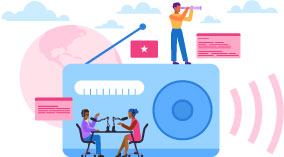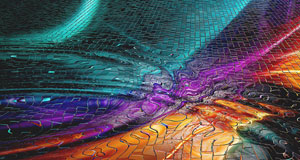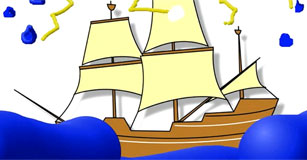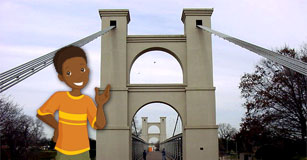Digital Storytelling Across the Curriculum
Find content’s deeper meaning

“By telling thoughtful stories, we clarify our own thinking about what we have learned to share with others in a profound way that sticks with us over time.”
—Annette Simmons, The Story Factor
In an age of mathematical, logical, and scientific thinking, storytelling is often considered appropriate only for language arts projects for young learners. However, in today’s information-loaded world, storytelling is being rediscovered as an effective tool for helping us make sense of this data barrage. According to the brain research explored by Roger Shanks, storytelling provides a memory structure and depth of context that engages learners in a sense-making of facts.
The digital storytelling process helps us transform isolated facts into illuminated, enduring understandings. By “living in the story,” we make information come emotionally alive. By exploring “lessons learned,” we go beyond telling about content to find its deeper meaning.
Storytelling Builds 21st-Century Skills
Creating digital stories provides us with important opportunities to practice and master a number of specific 21st-century skills, content, and technology standards (NETS). The process of crafting the digital story becomes rich in technical, communication, collaborative, oral speaking, creativity, visual and sound literacy, and project management skills. It also helps develop a range of digital communication styles necessary to function in a knowledge society. Since every good story requires great content that is worth sharing, digital storytellers must first become “meaning makers.” The written script requires deep understanding of the topic. From initial investigation to rough draft and then through refinement as draft after draft is polished and improved, writing should take about 40% of the project-building time.
Building 21st-Century Skills
- Creativity and inventive thinking
- Multiple intelligences
- Higher-order thinking (lessons learned)
- Information literacy
- Visual literacy
- Sound literacy
- Technical literacy
- Effective communication (oral, written, and digital)
- Teamwork and collaboration
- Project management
- Enduring understandings
The final narrative script is next recorded as a voiceover for the story. The author must work to ensure that the oral delivery has power and emotion. When an author “feels” his or her words, the voice becomes a conduit for others to experience the message.
Storytelling enables innovation and creativity. Authors become creative in designing information and communicating understandings with the images, graphics, movement, and music of digital media. Digital storytelling provides a unique opportunity to mix and dance media together until they coalesce into something that did not exist before.
Communication Across the Curriculum
Organizing story prompts around the type of communication expected of authors helps focus students as they develop the content of their stories. Here are four ideas for types of communication that connect storytelling with curriculum.
1. Myths, Legends, and Tall Tales
Myths, legends, and tall tales provide a familiar place to start. Most families and organizations use legends to represent values and pride. Myths help explain our cultural origins, values, and beliefs. Tall tales are romanticized exaggerations that highlight accomplishments or events. Justine, a classroom teacher in Arizona, has invited her third-grade students to create a multimedia tall tale about themselves, exaggerating their great qualities and achievements in a way that will be passed down to family and friends for generations to come.
- Create a myth about the origins of a modern-day invention to share with future generations.
- Develop myths from “what would happen if.”
- Create myths of “how things came to be” in your life, family, school, or business.
- Change a current event into a tall tale or myth.
- Develop a legend of a family member’s life or accomplishments.
- Create a legend of your own life for your great, great grandchildren to pass on.
- Create a fractured fairy tale using something from your own life.
- Create legends or tall tales of a literary character, mathematical concept, or social studies event.

2. Docudramas
Story prompts asking students to act as if they are living in the times or events they are studying helps make facts come alive for both authors and the audience. These docudramas require students to conduct in-depth research and practice their creativity to role-play a storytelling narrative as George Washington, a freed slave, a character in literature, the life of pi squared, a circle’s happiest accomplishments, or the lessons a Granny Smith apple learns from her life cycle.
Docudramas require learners to “step into the shoes” of a person or an object as a creative personal approach for weaving together significant facts. The event, person, or learning experience is expressed first-person, during which students demonstrate understanding of key concepts and deliver a lesson learned to reveal deeper thinking about their topics.
Jeanne Halderson’s Coulee Kids Podcasting students developed a community project honoring the contributions of women to their town. After the interviews were recorded and posted to iTunes, students created docudramas and reenacted the events and stories shared by the interviewees, synthesizing the entire interview and crafting a personal story showcasing the lesson learned.
- Create the storytelling journey of a leaf eaten by an earthworm. Make the facts come alive from beginning to end as if you were one of the digestive parts along the way.
- Be the youngest child of a Japanese family living in California, unfolding the facts and emotional experience of the Japanese internment camps.
- Be a decimal point, sharing your journey of being misunderstood and needing to clearly make a difference in the world.
- Be a literary, scientific, or historical character sharing a defining moment when a choice you made touched the world forever.
- Dialogue with another person across other eras or time periods, sharing your perspective and lessons learned on issues and events.
- Dialogue as parts of the brain on memorable experiences with the body.
- Be the pen that signed the Declaration of Independence, a treaty, or one of the Amendments, and explain how your life has impacted the lives of countless others.
Thread the beads of your facts together with a plot, so they don’t roll away.
—Annette Simmons, The Story Factor
3. Describe and Conclude
Describe and conclude tasks often require students to simply tell about a topic. To deepen the learning, ask students to share the wisdom of what they learned from the topic—the “so what?” developed from learning about people, events, or situations. A personal point of view can be added by asking: how does the event affect my life, thinking, or beliefs? How does knowing the facts about a famous person or event influence my own thinking or beliefs? This type of storytelling reflects the author’s full intellectual and personal engagement with the subject, not just a reporting of facts and information.
- Describe an event and why it matters, connects, or makes a difference to our humanity or communities today.
- Tell about a person and what his or her life or work has taught us—or perhaps how his or her work or choices in life continue to touch our lives today.
- Describe bees and what you now realize about their contribution or importance to our world.

4. Advertising or Public Service Announcements
This type of digital storytelling uses the power of personal appeal along with voice, music, and images to create influence and impact. Authors combine their personal messages with the lessons learned to provide a compelling call to action. A popular television version of this approach is the “Above the Influence” series calling attention to the consequences of choices made or not made.
- Help convince others to make better choices by sharing a defining moment when a decision or experience (e.g., drugs, guns, Internet chat rooms, dropping out of school, drinking, smoking, recycling our garbage, helping a friend, or stopping the bullying of others) changed or touched lives forever.
- Be a squirrel, eagle, bear, whale, or toucan convincing others to take care of the environment through a personal story of what happens when you do or what happens when you do not.
Telling stories together about things that really matter has an extraordinary effect on people. This effect is further magnified when the story is distributed and related meaningfully to the world community through the Web. May your students discover the magical power of releasing their own storytelling into your communities!













